Name Bernard Moitessier Role Sailor | Partner Ileana Draghici | |
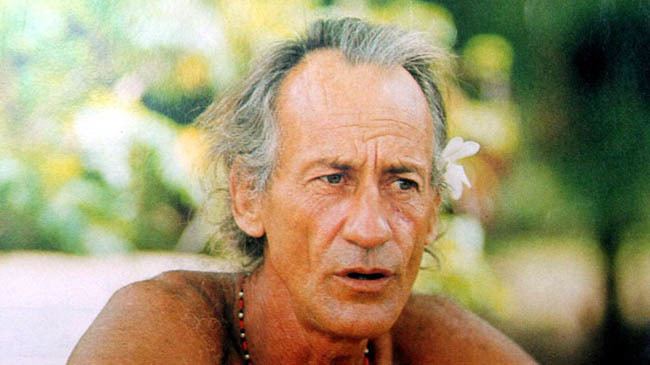 | ||
Died June 16, 1994, Vanves, France Spouse Francoise de Cazalet (m. 1961) Books The Long Way, La Longue route, Cape Horn: The Logical R, Vagabond des mers du sud, Tamata et l'alliance | ||
Bernard moitessier
Bernard Moitessier (10 April 1925 – 16 June 1994), a French national born and raised in Vietnam, was a sailor most notable for his participation in the 1968 Sunday Times Golden Globe Race, the first round the world yacht race. With the fastest circumnavigation time towards the end of the race, Moitessier was the likely winner but he elected to continue on to Tahiti again and not return to the start line in England, rejecting the idea of the commercialization of long distance sailing.
Contents
- Bernard moitessier
- Renowned french yachtsman bernard moitessier in deep water
- Vagabond of the South Seas
- Solo around the world
- Subsequent life
- Death
- Partial list of works
- References
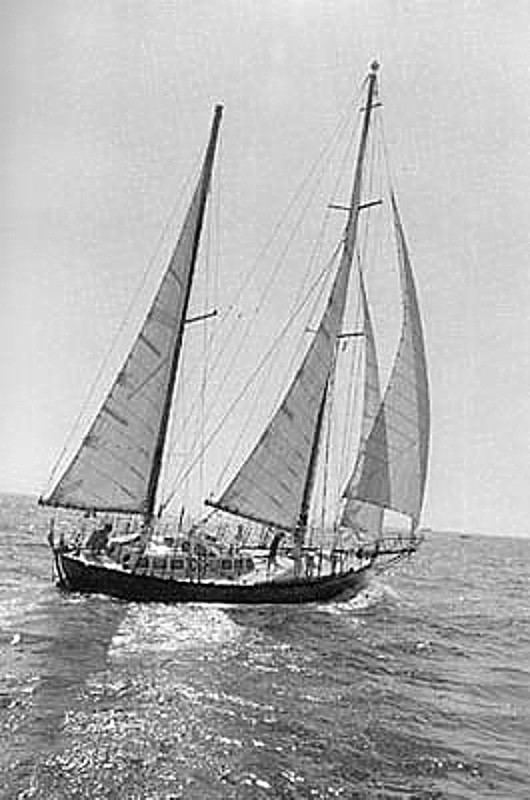
Renowned french yachtsman bernard moitessier in deep water
Vagabond of the South Seas
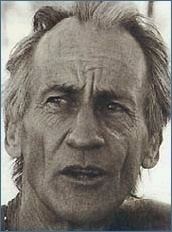
Moitessier grew up next to the sea in Indo-China and left it at the beginning of the Vietnam War as a crew member of sailing trade junks. In Indonesia he purchased the dilapidated junk Marie-Thérèse in 1952 to travel slowly further to France by singlehanded sailing. On the first leg to Seychelles he had to stop her from leaking in the middle of the Indian Ocean by diving underneath the boat at sea. After 85 days of sailing through monsoon weather he ran aground on Diego Garcia. He did not have modern navigational instruments, and was aware of his latitude via sextant observation but was estimating longitude and, as he tells it in "Sailing to the Reefs", neglected a three-knot ocean current, leading to the grounding. He was deported to Mauritius, because Diego Garcia is a military restricted area, and worked there three years before he could sail again in a boat he had built himself. This he sailed via stops in South Africa and St. Helena to the West Indies, but on a trip from Trinidad to St. Lucia he once again was shipwrecked due to physical exhaustion. Picked up and taken back to Trinidad by friends, he decided to go to France directly, as it seemed the only place he could earn enough to build himself a worthy boat. He was able to get work on a cargo ship which got him to France, via Hamburg, where he found work with a medical company whilst writing a book about his experience (Vagabond des Mers du Sud). He then moved to the south of France, where he married Françoise, the daughter of family friends, with whom he was to sail the world.
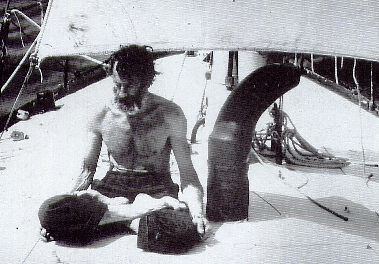
With the money from his book, he commissioned a 39' steel ketch which he named Joshua, in honour of Joshua Slocum, the first person to sail around the world solo. Finally he and Françoise left Marseille in October 1963, leaving her three children in boarding schools. After wintering in Casablanca they sailed first to the Canaries, then to Trinidad, and through the Panama Canal to the Galapagos Islands. After two years of spending time in each of these places they arrived at Tahiti, but realised that they were running out of time and that there was just eight months left to return to their children. So Moitessier proposed sailing Joshua home not via the Indian Ocean and Suez Canal, as originally planned, but eastwise, via the quickest route, including a passage about the much feared Cape Horn. Upon their arrival in France, at Easter, 1966, they had, without intending it, completed the longest nonstop passage by a yacht in history—14216 nautical miles, over 126 days, a world record which brought him immediate recognition throughout the world yachting community.
Solo around the world

Discussions between Moitessier and his friends Bill King and Loïck Fougeron about a solo non-stop trip around the world came to the notice of Robin Knox-Johnston who also started preparations before the Sunday Times offered their Golden Globe award for the first to circumnavigate alone, nonstop, and unassisted, and for the fastest elapsed time. Somewhat reluctantly, Moitessier decided to sail Joshua to Plymouth to meet the criterion for the race of leaving from an English port, but left months after several smaller and therefore slower boats.
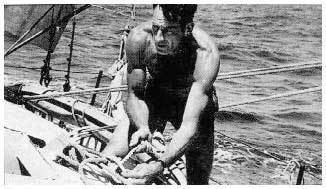
He departed Plymouth on 23 August 1968 and, after a quick passage south, he was off the Cape of Good Hope by 20 October 1968. In the process of transferring a canister of film and reports for the Sunday Times to a freighter, he allowed the bow of Joshua to be drawn into the stern of the ship, bending the bowsprit, which he was able to fix with winches on board. A couple of days later Joshua was knocked flat by a breaking wave but he was able to recover the damage. A succession of gales and calm periods characterised his trip through the Southern Ocean till he passed Cape Horn on 5 Feb 1969. In all this time he got no feedback on the progress of other competitors from local radio stations.
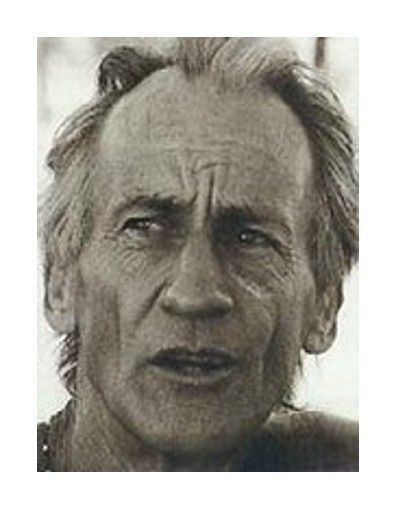
From the time of calms in the Indian Ocean where he was depressed and discovered yoga as a means of controlling his moods, he started to think of not returning to Europe which he saw as a cause of many of his worries. The aim of continuing his voyage on again to the Galapagos Islands strengthened as he passed through the Pacific though he was determined to complete the circumnavigation first. Finally having passed Cape Horn he had a crisis when a south-easterly gale started blowing him north again, and his account of his thought processes before he turned for the Cape of Good Hope reflects inner turmoil. However, the manner of his resignation, as he tells the story, is a key part of his reputation. He sent a message to his London Times correspondent by firing message by slingshot onto the deck of a passing ship, stating: "parce que je suis heureux en mer et peut-être pour sauver mon ame" ("because I am happy at sea and perhaps to save my soul").
The decision to abandon is instructive of Moitessier's character. Although driven and competitive, he passed up a chance at instant fame and a world record, and sailed on for three more months. Sir Robin Knox-Johnston went on both to win the race, as its only legitimate finisher, and to become the first man to circumnavigate the globe alone without stopping.
Although he abandoned the race, Moitessier still circumnavigated the world, crossing his path off South Africa, and then by sailing almost two-thirds of the way round a second time, all non-stop and mostly in the roaring forties, setting another record for the longest nonstop passage by a yacht, with a total of 37,455 nautical miles in 10 months. Despite heavy weather and a couple of severe knockdowns, he even contemplated rounding the Horn again. However, he decided that he and Joshua had had enough and, on 21 June 1969, put in at Tahiti, from where he and his wife had set out for Alicante, Spain, a decade earlier. He thus had completed his second personal circumnavigation of the world, including the previous voyage with his wife.
It is impossible to say whether Moitessier would have won if he had completed the race, as he would have been sailing in different weather conditions than Knox-Johnston. Based on his time from the start to Cape Horn being about 77% of that of Knox-Johnston, it would have been an extremely close race. Moitessier's book of the experience, The Long Way, tells the story of his voyage as a spiritual journey as much as a sailing adventure and is still regarded as a classic of sailing and adventuring literature.
Subsequent life
It took Moitessier two years to finish the book about his trip in Tahiti, during which time he met Ileana Draghici with whom he had a son, Stephan. They moved to the atoll of Ahe, where Moitessier attempted to cultivate fruit and vegetables. Ileana encouraged him to move to America to complete films about his sailing but he left after two years in his boat Joshua.
Joshua dragged her anchor and was beached, along with 22 other yachts, by a freak onshore storm at Cabo San Lucas in early December, 1982. Bernard set Joshua afloat, then gave her for a few symbolic dollars to Joe and Reto who had the youth and strength to make her sail again. Today she is restored and berthed as part of a maritime museum in La Rochelle, France. After further travels, Moitessier returned to Paris to write his autobiography.
Moitessier was an environmental activist who protested against nuclear weapons in the South Pacific and against overdevelopment of the Papeete waterfront in Tahiti.
Death
Moitessier died of prostate cancer on 16 June 1994 and is buried in an informal corner of the formal main cemetery in Bono, in Brittany, France. Visitors to his grave leave thematic gifts such as slingshots, creating some elements of a shrine.
